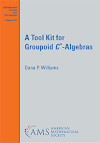- About MAA
- Membership
- MAA Publications
- Periodicals
- Blogs
- MAA Book Series
- MAA Press (an imprint of the AMS)
- MAA Notes
- MAA Reviews
- Mathematical Communication
- Information for Libraries
- Author Resources
- Advertise with MAA
- Meetings
- Competitions
- Programs
- Communities
- MAA Sections
- SIGMAA
- MAA Connect
- Students
- MAA Awards
- Awards Booklets
- Writing Awards
- Teaching Awards
- Service Awards
- Research Awards
- Lecture Awards
- Putnam Competition Individual and Team Winners
- D. E. Shaw Group AMC 8 Awards & Certificates
- Maryam Mirzakhani AMC 10 A Awards & Certificates
- Two Sigma AMC 10 B Awards & Certificates
- Jane Street AMC 12 A Awards & Certificates
- Akamai AMC 12 B Awards & Certificates
- High School Teachers
- News
You are here
A Tool Kit for Groupoid C∗-Algebras

Buy Now:
Publisher:
AMS
Publication Date:
2019
Number of Pages:
398
Format:
Hardcover
Series:
Mathematical Surveys and Monographs
Price:
129.00
ISBN:
978-1-4704-5133-2
Category:
Monograph
[Reviewed by , on ]
Elizabeth Gillaspy
06/7/2021
This graduate-level textbook is a comprehensive, readable introduction to the fundamental theory of groupoid \( C^{*} \)-algebras. Dana Williams has been researching second countable locally compact Hausdorff groupoids and their \( C^{*}\)-algebras since their introduction forty
years ago by J. Renault. In this book, Williams shifts smoothly between providing the ”bird’s eye view” context of cornerstone theorems such as Renault’s Disintegration Theorem and working through the intricate details of their proofs.
In contrast to other introductory references (cf. A. Sims, “Hausdorff étale groupoids and their \( C^{*} \)-algebras", in Operator Algebras and Dynamics: Groupoids, Crossed Products, and Rokhlin Dimension.), A Tool Kit treats the general theory of the \( C^{*} \)-algebras associated to second countable locally compact Hausdorff groupoids. To quote Williams, “Sadly, there is lots of measure theory out there in [locally compact Hausdorff] groupoid land,” which Williams’ treatment doesn’t shy away from. (Similar glimpses of Williams’ sense of humor surface frequently throughout the book.) Williams evidently believes that locally compact Hausdorff groupoids are a happy medium for \( C^{*} \)-algebras: they require less technical finesse than Borel groupoids (cf. C. Anantharaman-Delaroche and J. Renault, Amenable Groupoids. L’Enseignement Mathématique 36, Genéve, 2000) or locally Hausdorff groupoids such as foliation groupoids, but provide more examples of \( C^{*} \)-algebras than do étale groupoids.
Williams’ target audience consists of mid-career graduate students and established researchers hoping to learn more about groupoid C ∗ -algebras. The book is very readable, whether you’re looking for the big picture or the nitty-gritty. To aid ”bird’s eye” readers, Williams states the key theorems as soon as the necessary notation and motivation have been introduced. On occasion, this means relegating to Chapter 4 the proofs of theorems that are initially stated in Chapter 2. He also includes a detailed overview of the ”plan of attack” for most chapters, although this overview isn’t generally found on the first page of the chapter. For example, the overview for Chapters 9 and 10 occupies the last four pages
of Section 9.2.
Graduate students planning to pursue research in groupoid \( C^{*} \)-algebras will be particularly appreciative of Williams’ detailed and self-contained treatment of the foundational results on groupoid \( C^{*} \)-algebras. The proof of the Disintegration Theorem and the detailed
discussion of groupoid amenability, in particular, make their first appearance in textbook format in A Tool Kit and were heretofore rather intimidating to extract from the literature. Williams takes pains to spell out the key ideas underlying each proof, and the not-infrequent
long computations are generally broken up by explanations of the manipulations transforming one line to the next. Still, reading this textbook requires an alert brain. Typos (and notational inconsistencies, such as using a backslash to denote both set difference and a quotient by a left action) occur just often enough to keep the reader on their toes. Each section concludes with a number of exercises, solutions to which are included in an appendix.
Although A Tool Kit is relatively self-contained, Williams frequently refers the reader to his earlier textbooks for important technical results as well as motivation. In addition to a familiarity with basic \( C^{*} \)-algebra theory, Williams assumes a working knowledge of Morita equivalence as well as group\( C^{*} \)-algebras and crossed products. Borel Hilbert bundles are undoubtedly the most esoteric component of the prerequisite material (but can be found in Appendix F of Williams' Crossed Products of \( C^{*} \)-Algebras.
If you’re curious about how and why the theory of groupoid \( C^{*} \)-algebras seems so much more complicated than group \( C^{*} \)-algebra theory, pick up a copy of Williams’ A Tool Kit for Groupoid \( C^{*} \)-Algebras. The frequent remarks, examples, and big-picture discussions will
help keep your head above water as Williams guides you through the unavoidable sea of technical details. Both the carefully detailed proofs and the bird’s-eye view found in A Tool Kit are new and welcome additions to the literature on groupoid \( C^{*} \)-algebras. No textbook can make groupoid \( C^{*} \)-theory easy, but A Tool Kit for Groupoid \( C^{*} \)-Algebras finally makes it accessible.
Elizabeth Gillaspy is an assistant professor of mathematics at the University of Montana.
See the publisher's website.
- Log in to post comments




